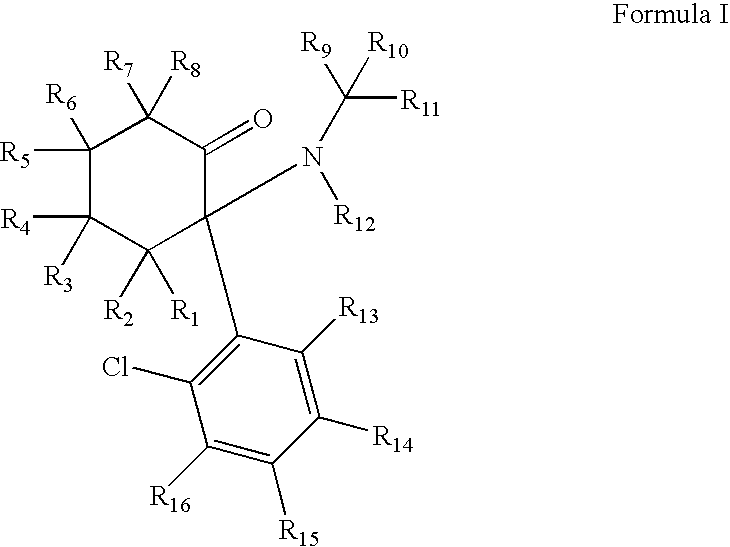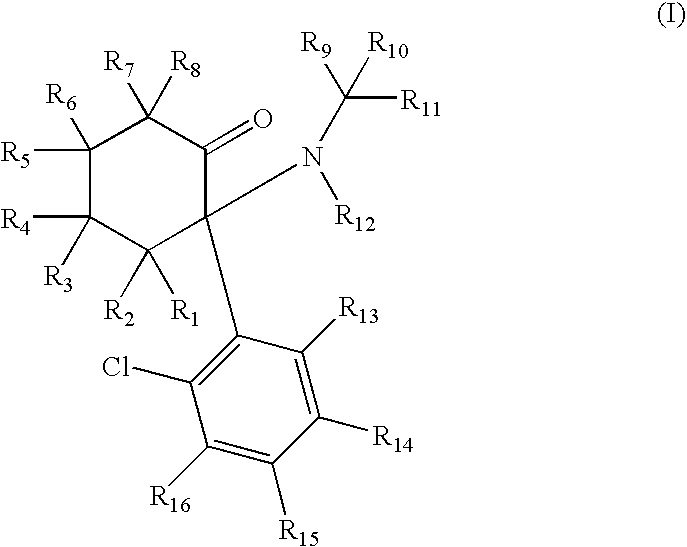Substituted cyclohexanones
a technology of cyclohexanone and receptor, which is applied in the direction of antibacterial agents, drug compositions, antinoxious agents, etc., can solve the problems of more overall side effects, minor effects, and vacuole formation in animals
- Summary
- Abstract
- Description
- Claims
- Application Information
AI Technical Summary
Benefits of technology
Problems solved by technology
Method used
Image
Examples
example 1
d12-2-(2-Chlorophenyl)-2-methylamino-cyclohexanone (d12-Ketamine)
[0276]
Step 1
[0277]
[0278]d9-(2-Chlorophenyl)-cyclopentyl-methanone: The procedure of Step 1 is carried out as described in U.S. Pat. No. 3,254,124. d9-Cyclopentylbromide (about 120 g; available commercially from Sigma-Aldrich, St. Louis Mo. 63103) and magnesium turnings (about 19.4 g) are used to make the corresponding Grignard reagent, which is then reacted with 2-chlorobenzonitrile for about 3 days and hydrolyzed using d1-hydrochloric acid in deuterium oxide to give the title product.
Step 2
[0279]
[0280]d8-(1-Bromocyclopentyl)-(2-chlorophenyl)-methanone: The procedure of Step 2 is carried out as described in U.S. Pat. No. 3,254,124. d9-(2-Chlorophenyl)-cyclopentyl-methanone (about 21 g) is treated with bromine (about 10 g) in carbon tetrachloride (about 80 mL). The title product is isolated by standard extractive workup and used immediately in the next step without any further purification.
Step 3
[0281]
[0282]d11-1-[(2-Ch...
example 2
d3-2-(2-Chlorophenyl)-2-methylamino-cyclohexanone hydrochloride
[0287]
Step 1
[0288]
[0289](1-Bromocyclopentyl)-(2-chlorophenyl)-methanone: (2-Chlorophenyl)-cyclopentyl-methanone (1 g, 4.80 mmol) was treated with copper(II) bromide (2.7 g, 12.09 mmol) in ethyl acetate (10 mL). The mixture was heated at about 80° C. for about 2.5 hours. The mixture was filtered, the filtrate was evaporated, and the crude residue was washed with hexane to give the title product (1.25 g, 91%). 1H NMR (300 MHz, CDCl3) δ 7.72 (d, J=7.5 Hz, 1H), 7.46-7.28 (m, 3H), 2.46-2.29 (m, 4H), 2.03-1.93 (m, 2H), 1.90-1.83 (m, 2H); LC-MS: m / z=288 (MH)+.
Step 2
[0290]
[0291]d3-1-[(2-Chlorophenyl)-methylimino-methyl]-cyclopentanol hydrochloride: At about −30° C., (1-Bromocyclopentyl)-(2-chlorophenyl)-methanone (1 g, 3.48 mmol) was treated with liquid methylamine (approx. 2 mL). After about 1 hour, the excess methylamine was evaporated, and the resulting residue was dissolved in hexane and re-evaporated. The residue was dissol...
example 3
d11-2-(2-Chlorophenyl)-2-methylamino-cyclohexanone hydrochloride
[0294]
Step 1
[0295]
[0296]d8-(2-Chlorophenyl)-cyclopentyl-methanone: d9-Cyclopentylbromide (2 g, 13.4 mmol) and magnesium turnings (1.85 g, 77.1 mmol) were used to make the corresponding Grignard reagent, which was then mixed with 2-chlorobenzonitrile (1.85 g, 13.2 mmol), copper (I) bromide (100 mg, 0.7 mmol) and diethyl ether (40 mL). The mixture was heated at reflux for about 16 hours and then hydrolyzed for about 2 hours at ambient temperature using 6N hydrochloric acid (10 mL). After standard extractive workup, the crude product was purified by column chromatography on silica gel (petroleum ether-ethyl acetate=70 / 1, v / v, elution) to give the title product. 1H NMR (300 MHz, CDCl3) δ 7.69-7.26 (m, 4H), 3.55 (s, 1H); LC-MS: m / z=217 (MH)+.
Step 2
[0297]
[0298]d8-(1-Bromocylopentyl)-(2-chlorophenyl)-methanone: d8-(2-Chlorophenyl)-cyclopentyl-methanone (400 mg, 1.84 mmol) was treated with copper (II) bromide (1.22 g, 5.46 mmol...
PUM
| Property | Measurement | Unit |
|---|---|---|
| time | aaaaa | aaaaa |
| weight | aaaaa | aaaaa |
| size | aaaaa | aaaaa |
Abstract
Description
Claims
Application Information
 Login to View More
Login to View More - R&D
- Intellectual Property
- Life Sciences
- Materials
- Tech Scout
- Unparalleled Data Quality
- Higher Quality Content
- 60% Fewer Hallucinations
Browse by: Latest US Patents, China's latest patents, Technical Efficacy Thesaurus, Application Domain, Technology Topic, Popular Technical Reports.
© 2025 PatSnap. All rights reserved.Legal|Privacy policy|Modern Slavery Act Transparency Statement|Sitemap|About US| Contact US: help@patsnap.com



